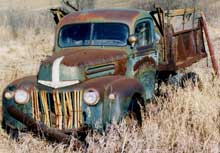The summer I turned seven my parents bought their first house. It was old and run down, and among other things needed a new driveway. My father hired Foss Webb, owner of Webb’s Trucking, to deliver some gravel.
Mr. Webb had two Ford dump trucks, of the type at the top of this page. Knowing I was fascinated with cars and trucks and machinery of all kinds, he invited me to ride along on one of his many trips to the gravel bank. When I asked the year of the trucks, he told me the one in which I was riding was a 1945, the other a 1942. This surprised me on two counts, because I hadn’t realized that the style had been introduced before the war, nor that Ford built trucks in 1945, which I knew was a war year.
My friend Jim Wagner, Ford truck guru and author of the definitive book Ford Trucks Since 1905, explains that the new style, with high front fenders and “waterfall” grille but retaining cab of the 1940-41 type, was introduced for 1942. Headlamps, which were fender mounted in 1940-41, were faired into the “catwalk” area next to the grille, in contrast to Dodge, which still had bug-eyed lights, and Chevy, GMC and Studebaker, who only partially faired them. The only American light truck manufacturer, aside from Ford, offering fully-faired lights was International. Cab-over-engine Fords retained the 1938 cab and 1941 nose.
Although production of civilian cars and trucks halted early in 1942, trucks for the military services were delivered right through 1943 and into ’44, by which time a few civilian deliveries were again authorized by the government. In the spring of 1945, civilian truck production resumed in earnest and the 31 millionth Ford, a pickup, was completed on May 3rd. The style remained in production until replaced by the new F-series trucks in January 1948.
One thing that intrigued me about Mr. Webb’s trucks was that while his 1945 dump truck was the very common Village Green with Tacoma Cream trim the ’42 was painted in a reverse combination, tan cab with dark green trim. I have since wondered if this was a pre-war offering, as I’ve never seen another. Jim Wagner says that while ’42 Ford trucks were offered in seven passenger car colors, tan was not among them. By 1945, trucks colors were Niles Blue-Green, Fathom Blue, Moselle Maroon, Village Green and Newcastle Gray. At various times, Vermilion Red and other passenger car colors were offered, but after October 1946 Village Green was made standard. Throughout this period, however, special fleet paint jobs, like this Railway Express truck, were common. That explained why most Ford trucks of that era I had seen were green. It also suggests that Mr. Webb’s “reverse” painted 1942 dump truck had either been supplied as part of a special fleet order or repainted by a subsequent owner.
There are plenty of “waterfall” Fords around, though some are in pretty precarious condition. They remain some of my favorite trucks, especially in Village Green. The sound of a V8 climbing a hill in an intermediate gear is music to my ears.

